On a ‘Toxic Tour’ of Curtis Bay in South Baltimore, Visiting Academics and Activists See a Hidden Part of the City
Harm City: First in a series about environmental justice and climate adaptation in Baltimore’s neighborhoods.
Nicole Fabricant seemed like a natural guide. A professor of anthropology at Towson University, she’d spent years researching historically marginalized communities, like South Baltimore. Together with fellow academics from Johns Hopkins, she served on the advisory board of a project called “Right to the City.” And now, late one morning in May, she sat next to a grassy ballfield behind the Curtis Bay Recreation Center, waiting for colleagues to help her lead a “toxic tour.”
For Fabricant, it was a special day and one long in the making, with a group of activists and academics from the United Kingdom and Brazil on hand to walk the streets of Curtis Bay, a poor, predominantly Black neighborhood surrounded by industry and choked by traffic.
Fabricant, 46, who received her Ph.D. in urban anthropology from Northwestern, previously studied socio-economic themes across Latin America involving displaced peasants, informal laborers and intellectuals fighting for land redistribution and small-scale farming.
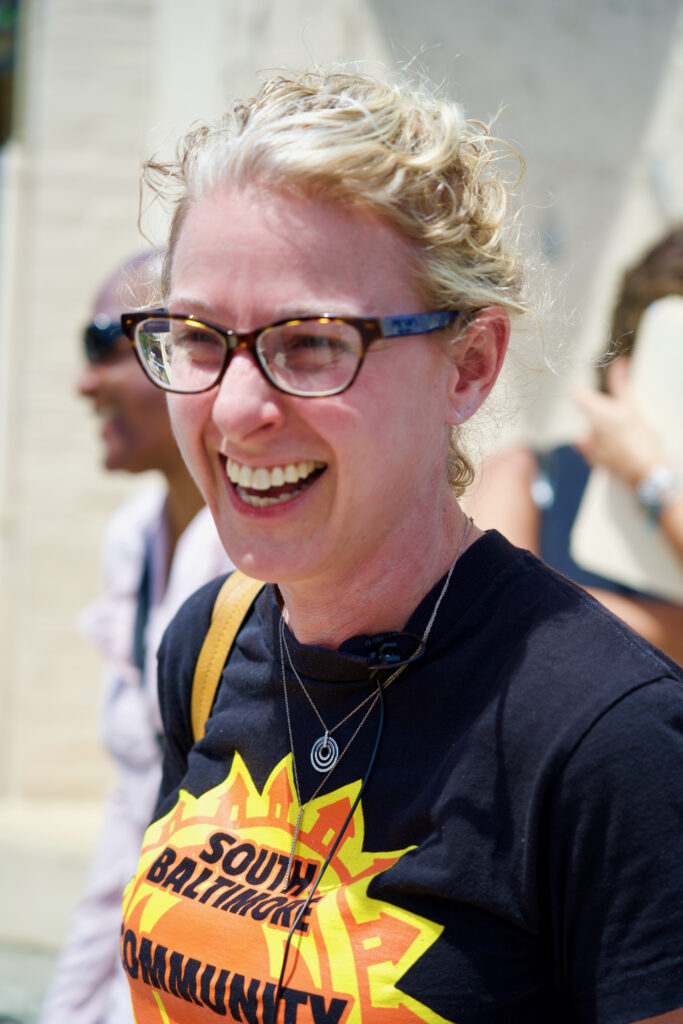
But in recent years she’s transferred her research interests—and activism—to her own backyard, finding South Baltimore rife with the kind of environmental health inequities that led to creation of America’s environmental justice movement in the late 1980s.
“There’s Shashaunda,” she said, greeting Shashaunda Campbell, 26, who became an activist in the neighborhood as a high school student 13 years ago and is now a member of the staff at South Baltimore Community Land Trust.
“And here’s Matty,” Fabricant said, introducing Matthew Aubourg, 23, a student at John Hopkins Bloomberg School of Public Health who is collecting air pollution data.
“I just want to let you know that this is a part of Baltimore that often is left off the map of Baltimore,” Fabricant said to her guests as the tour began. “This is deep south and you will begin to see some of those communities and some of the racialized geography of the city.”
Dressed in black jeans and a black sweatshirt with the words “South Baltimore Community Land Trust” splashed across the front in bright orange lettering, she pointed out that a wave of gentrification is creeping towards the adjoining all-Black neighborhood of Cherry Hill.
“We will talk about rights to land and reclaiming land for working and poorest people,” she said. “We will talk about the right to clean air that is compromised everyday by cumulative impacts of at least 15 to 20 toxic facilities which we will see in this community.”
The Curtis Bay Recreation Center served as a fittingly symbolic place to begin: “This is the community’s only recreation center, and they are trying to move it away from the community,” she said of Baltimore city officials, ”because the plan is to make this all industrial and displace the residents that remain in the neighborhood.”
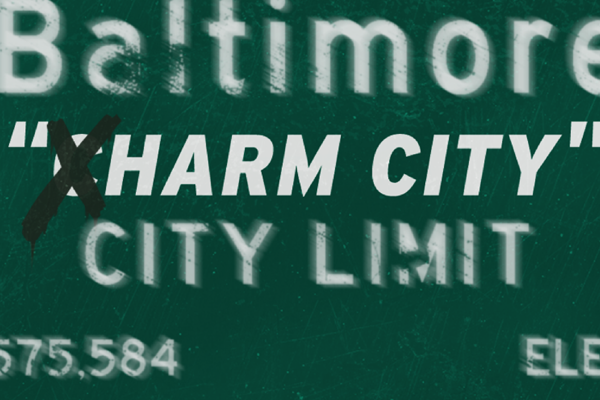
For months, Fabricant and Campbell, alongside community groups and Curtis Bay residents, have attended many meetings and tried to convince city officials that shuttering the recreation center would further downgrade their quality of life. But their efforts were met with promises of a better facility the city would construct elsewhere, which wasn’t what they wanted to hear.
“Curtis Bay will be getting a brand-new, modern, state-of-the-art recreation center just three blocks away from the current Curtis Bay Recreation Center and across the street from Curtis Bay Elementary School,” Baltimore Mayor Brandon Scott said in an emailed statement.
The new location would not only benefit Curtis Bay, he said, but serve parts of the Brooklyn and Brooklyn Homes communities, providing easier access for neighborhood students because of its proximity to schools.
“The fact that Curtis Bay Recreation Center still resides in a building more than half a century old and this community has not gotten this investment until now is an extension of environmental injustice. These investments are helping Baltimore flip the script and uplift all of our communities, no matter where they are in the city,” Scott said.
Lester Spence, a professor of political science at Johns Hopkins University who has been active in the fight to preserve the city’s Black neighborhoods since 2005, provided the countervailing argument: “The people who live in cities have an inherent right to the city,” he said.
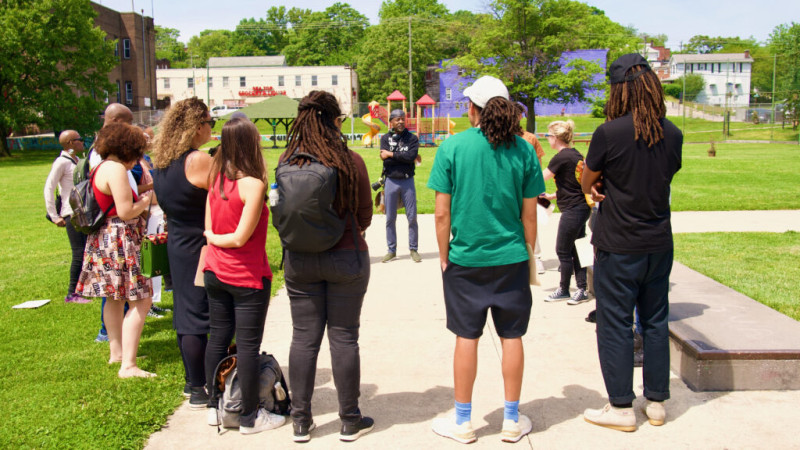
Soon, Fabricant and Campbell were distributing file folders with background material on Curtis Bay to all those assembled in the rowhouse neighborhood, which is about four blocks wide and 15 blocks long.
“The first stop today is going to be about some of the ways scientists are collaborating with us,” Fabricant said. “We have a citizen science project. And we believe that If we get the right data, we can use it to hold the city, the state and the federal government accountable.”
She called the approach “radical science.”
The Worst Air Quality in Maryland
They walked in a beeline down Curtis Avenue, avoiding the traffic whizzing by in regular intervals, past a grayish-white prefab rectangular structure stretching along the road on the other side for almost quarter of a mile.
Campbell wondered if the warehouse was constructed at this exact location to hide the mountainous open-air coal pits on the other side, a stone’s throw from the playground where the toxic tour had begun.
The pits are part of the country’s second largest coal export operation, which processes millions of tons of coal brought by train from Appalachia for shipping to other states and exported internationally.
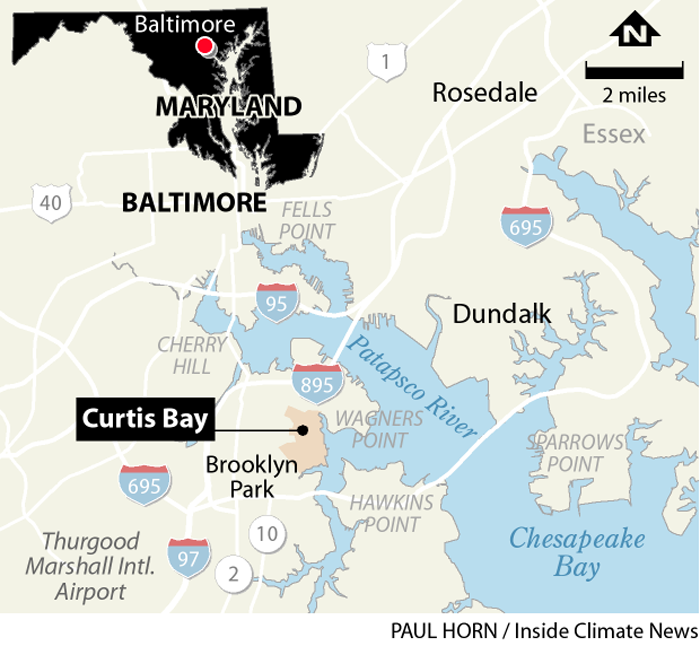
Less than a year ago, a coal pier there was the site of an earth-shaking explosion, eventually traced to inadequate ventilation in a conveyor belt tunnel that led to a build up of methane gas. It shattered nearby windows and terrified the community, which had feared such an eventuality in view of large quantities of coal being transported in unmarked trains and flammable fuel stored in giant tanks not far from homes, playgrounds and places of worship.
“People were scared, their kids were traumatized. You can’t even imagine the panic that was happening,” Campbell recalled. “People thought bombs went off. And when it happened, there were no officials there. None.”
The Maryland Department of the Environment, the state’s environmental regulator, later imposed a $15,000 penalty on the company and a $100,000 contribution to the South Baltimore Community Land Trust, which the activists called a slap on the wrist that failed to prevent a similar accident in future.
“This is owned by CSX, a federal railway worth $18 billion. It’s privately owned and is under the regulation of the federal government in the United States,” Fabricant explained, deliberately pacing her words for the interpreter who was constantly whispering Portuguese for the Brazilians on the tour.
“We cannot do anything about holding the city accountable for the damage it caused right in this community. They say we have nothing to do with it, go change the laws through Congress,” she said, almost rolling her eyes.
The explosion at the Curtis Bay coal operation was not the only industrial accident to have hit the community. In 2017, a fire tore through row houses across from the recreation center, destroying 10 homes and displacing nearly two dozen residents. Turned out that the fire hydrant right around the corner was dry, Campbell told the group, as were others in a two-block radius.
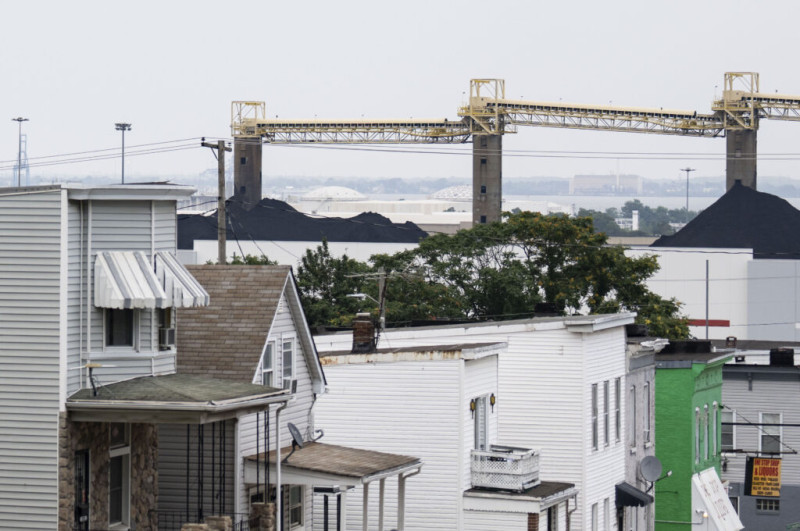
Campbell wondered why it is that Baltimore Mayor Brandon Scott was quick to say the city wouldn’t take shipments of toxic wastewater from the train wreck earlier this year in East Palestine, Ohio, but refuses to take a stand against the environmental injustices in Curtis Bay.
The group finally assembled around the air quality monitoring unit mounted on a thin pole stuck in the sidewalk on Church Street.
“Right now, we’re in the stage of gathering the data and doing quality control to make sure that it’s manageable,” said Aubourg, calm and studious, referring to his Hopkins colleagues. “And we’re also starting to build up a network into other South Baltimore communities that are experiencing similar environmental justice issues.”
Campbell recalled how the state’s environmental regulator—the Maryland Department of the Environment—had an air quality monitoring unit installed in the nearby Baybrook area, which recorded the third highest concentrations of fine particulate matter air pollutants, known as PM2.5, in Baltimore City in 2007.
“The air monitor showed that Curtis Bay was the most polluted zip code,” she said. “So, when they took the air monitor away in 2008, they just stopped tracking the sickness or the illnesses that probably happened because of the air pollution. That data wasn’t collected.”
Almost taking over for Campbell, Fabricant said that the MDE was “a deregulated toothless entity” that did little to protect the environment, which it is mandated to do. “I’m sure it’s the same in London or in Brazil,” she said.
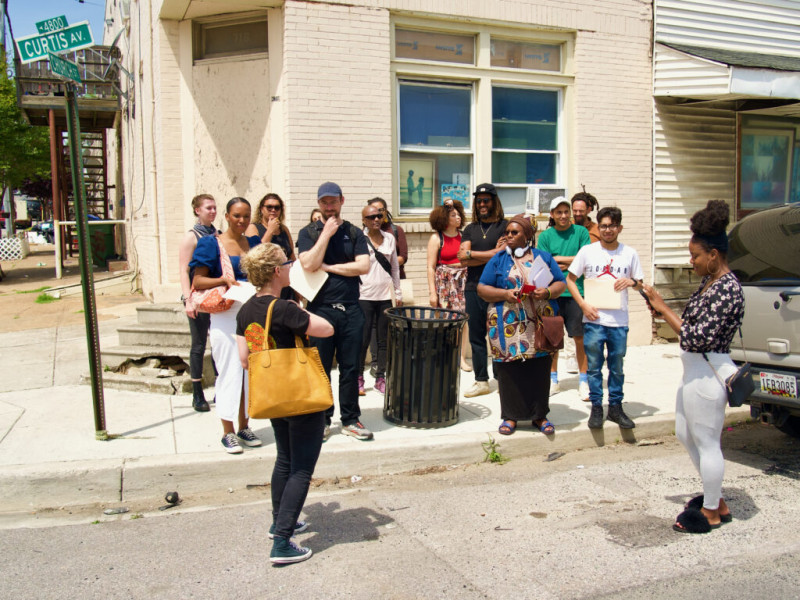
Adam Elliott, an anti-racism activist affiliated with Queen Mary University in London, asked if the air monitoring unit collected data that could be used for analyzing respiratory illnesses in the neighborhood.
“They pick up a suite of pollutant parameters, including particulate matter, which is probably one of the most common air pollutants of concern,” Aubourg said, adding that the unit can also detect particulate matter of different sizes that helps determine whether the emissions are from diesel trucks and vehicular traffic or from other sources such as coal terminals.
As the road traffic picked up, the Johns Hopkins graduate student occasionally lost his voice in the whirr and blaring horns from the trucks as they whizzed by.
The air monitoring unit was connected to a cellular network and posted data online for anyone to access it, Aubourg continued, and scanned for carbon dioxide, carbon monoxide, nitrous oxide and nitrogen dioxide, in addition to particulates.
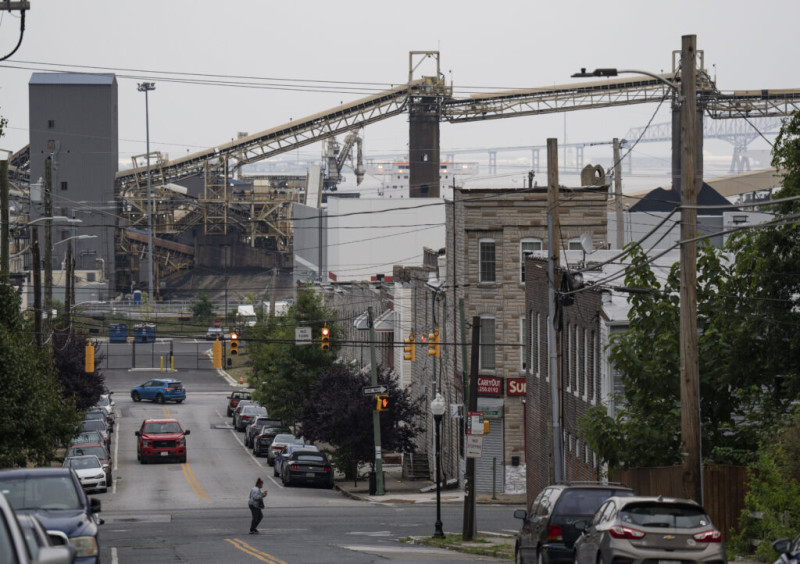
“It allows us to have a pretty comprehensive view of what air quality and air pollution looks like in the area,” he said, adding that a camera was also installed near the coal piers that recorded the activity at the terminals throughout the day.
Aubourg said it helped experts link spikes in particulate matter pollution to any uptick in industrial activity at the piers, as bulldozers and cranes shoveled coal at the terminals.
By collecting and aggregating the air pollution data from Curtis Bay, Aubourg said, the citizen science project was reinforcing residents’ demand to move the industry away from their doorstep.
“Matty is the one who’s building networks,” Fabricant said. “None of this, right, would be possible without Matty. This is public health at its best.”
Victory on a Vacant Lot
The tour participants piled into four cars for a one-mile drive to the next stop: a large abandoned lot on Pennington Avenue. Now an industrial peninsula covered in brownfields, it was once home to a thriving Black community in the 1940s and ‘50s, Fabricant explained, and was gradually depopulated by the 1990s because of a high risk of cancer and other illnesses from the industrial activity nearby.
This was also the site of the abandoned Fairfield Renewable Energy Project that Baltimore city had approved for construction in 2010. Energy Answers International, the project’s developer, had boasted at the time that the $1 billion project would have been the nation’s largest trash-to-energy incinerator.
In 2011, Maryland’s the-Democratic governor, Martin O’Malley, signed legislation making the electricity generated from burning trash a “tier one” renewable energy on a par with wind, solar and geothermal, even though such incinerators spew large quantities of lead, mercury and other harmful pollutants into the air.
To this day, Baltimore remains heavily invested in trash-to-energy incinerators, having signed a new 10-year contract in late 2020 with the Wheelabrator trash incinerator, the city’s largest standing source of air pollution, just off Interstate 95 about 6.5 miles north of Curtis Bay near downtown.
The Fairfield Renewable Energy Project would have emitted 240 pounds of mercury and 1,000 pounds of lead into the air annually—but then Campbell and her classmates at Benjamin Franklin High School entered the picture.
This vast vacant lot, stop three on the tour, stands as a testament to their “Free Your Voice” campaign from 13 years ago,
“When we started Free Your Voice at the Benjamin Franklin High School, it wasn’t because of the incinerator,” she said. “It was because students came together to talk about issues they saw like asthma, respiratory issues, and even cancer in some families. We didn’t link it to different sources of pollution when we were younger.”
The elected city council members at the time dressed up the incinerator proposal as beneficial for the community because it would bring jobs to the area, but didn’t mention its health impacts, Campbell said.
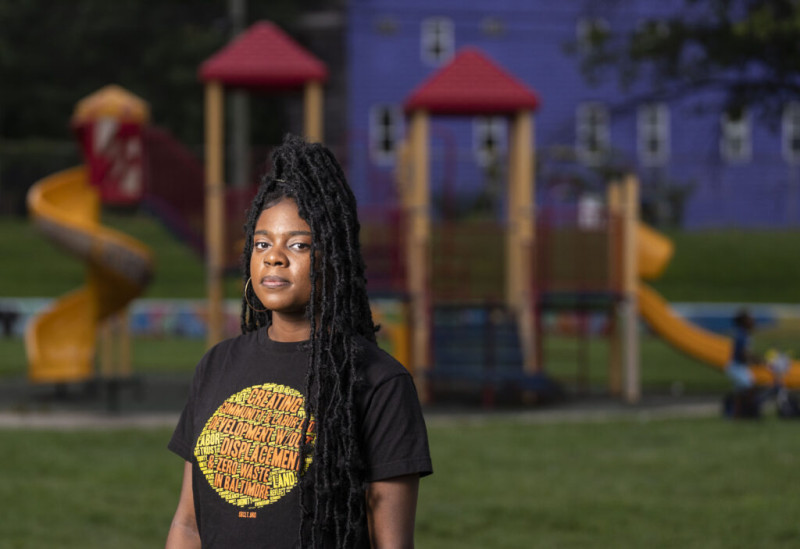
The students’ research led them to discover the toxic pollutants the incinerators would emit, she said, prompting a door-to-door campaign to make residents aware of what was coming. “Some of them were like, ‘This happens all the time. This isn’t new,’” she said with a hint of irony.
They pushed ahead, reaching out to other public schools in Baltimore City, local nonprofits and government agencies, urging them to divest from the project.
In 2015, the city decided to back out of its contract with the project developer, eventually bringing construction to a halt a few months later under mounting pressure from activists and environmentalists.
It marked a rare victory for Curtis Bay, but the Energy Justice Network would later calculate that three other trash incinerators in Baltimore would receive $38 million in subsidies under something called the Renewable Energy Credits mechanism between 2012 and 2016, with millions more to follow.
In 2020, 60 nonprofit organizations sent an open letter to then Gov. Larry Hogan, a Republican, in support of ending the state incentives for trash incineration, urging the administration to support the development of alternatives such as composting.
“Air pollutants from waste incinerators increase the risk of pre-term births, cancers of the blood and lung, and emergency room visits,” the letter said.
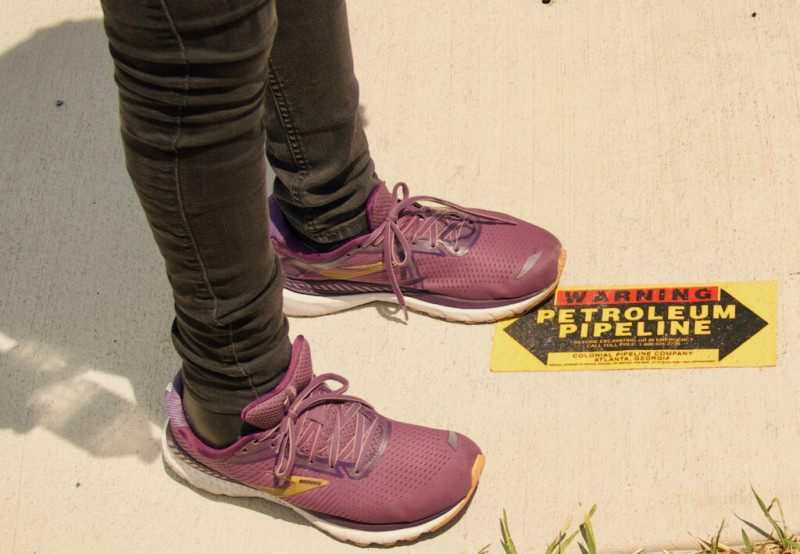
And in March, environmental advocates—Campbell among them—expressed their anger when legislation removing trash incinerators from the state’s renewable energy portfolio failed to pass during Maryland’s last legislative session, despite a newly elected Democratic governor, Wes Moore, who spent considerable time during his 2022 campaign promising to revive Baltimore and make Maryland a national leader in renewable energy.
Standing out by the vacant industrial wasteland under a hot May sun, Campbell described how hard it was for those in the Curtis Bay community to reclaim their rights in bits and pieces during all those years of organizing and campaigning.
The South Baltimore Community Land Trust is currently developing 15 affordable housing units in Curtis Bay and the neighboring Cherry Hill area. The housing facilities are built as “passive homes,” Fabricant said, an ecological design that’s energy efficient and would lower energy bills by 90 percent through weatherization and insulation.
“As we build this movement, we’re hoping people will begin to take back Curtis Bay little by little, block by block. So the sustainable green industries and co-ops become more of a norm,” she said, with a hint of optimism.
“The Wakanda of South Baltimore”
The Filbert Street Garden, a little over half a mile away, was the tour’s final stop. If the vacant lot was a reminder of industrial encroachment that hollowed out the neighborhood, the vegetated green patch on Filbert Street showed the community’s resilience.
Fabricant welcomed the group to the garden and inquired if everyone was ready for lunch, pointing towards the food that was already set up at the picnic tables under the green shade.
She apologized that Marvin Hayes, the garden’s caretaker, couldn’t attend the meeting. “We were hoping to end this tour with his energy. He refers to the garden as the Wakanda of South Baltimore,” Fabricant said with amusement, describing the garden as an “agro ecological utopia” amidst the industrial encirclement.
The group had splintered—some sat on tables, others savored the shaded tree cover, some walked around looking at the variety of cultivated greens. “We have the largest native bee population in the state of Maryland,” Fabricant said. “So honey comes directly from the garden. There’s chickens that lay eggs. Any kid can come and play with the goats and get eggs after school. It’s totally a public space.”
Fabricant said Hayes wants to spread “compost fever” from the garden to the rest of Baltimore, seeing composting as a potent metaphor of neighborhood empowerment and a way to counter the multi-million dollar incinerator at the edge of the city, which ate into public money and left behind a trail of toxic pollutants.
Starving the incinerator might be a long way away, but sorting food scraps from the waste stream was much more doable for those who live in Curtis Bay. Which highlights Hayes’ challenge: getting enough residents to participate to make the green revolution he envisions a reality. Could he convince the young volunteers who worked at the garden that composting is a viable substitute for incineration?
Coming in Part 2: Marvin Hayes spends his Saturdays collecting food waste across Baltimore, preaching the gospel of composting in the city’s most affluent neighborhoods and, at times, confronting racism there.
Disclaimer: The copyright of this article belongs to the original author. Reposting this article is solely for the purpose of information dissemination and does not constitute any investment advice. If there is any infringement, please contact us immediately. We will make corrections or deletions as necessary. Thank you.







